8+ Sample Grievance Meeting Minutes
-
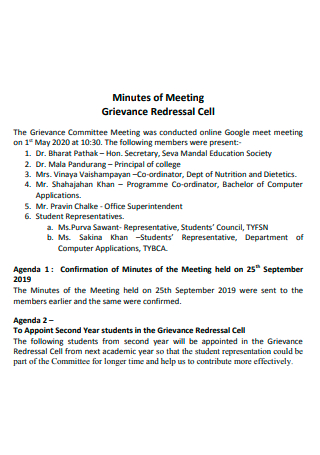
Grievance Redressal Cell Meeting Minutes
download now -
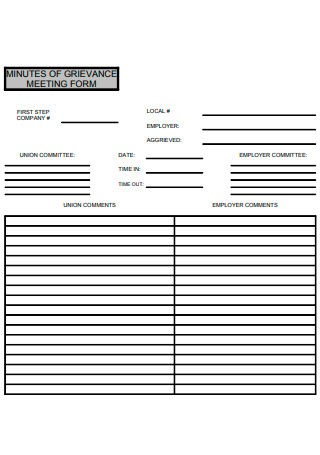
Grievance Meeting Minutes Form
download now -
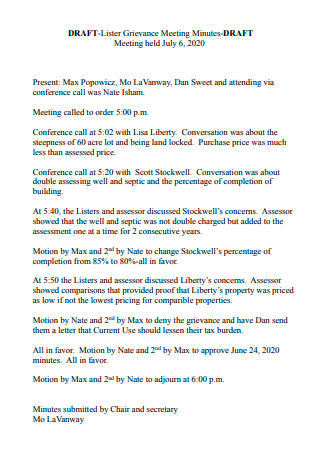
Draft Grievance Meeting Minutes
download now -
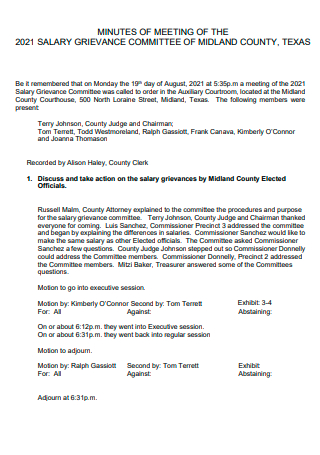
Salary Grievance Committee Meeting Minutes
download now -
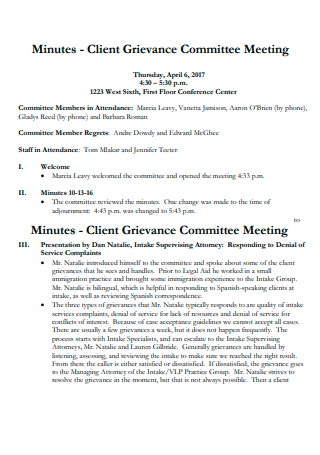
Client Grievance Committee Meeting Minutes
download now -
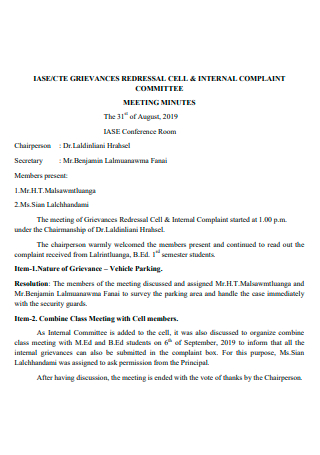
grievance Redressal Cell and Internal Complaint Committee Meeting Minutes
download now -
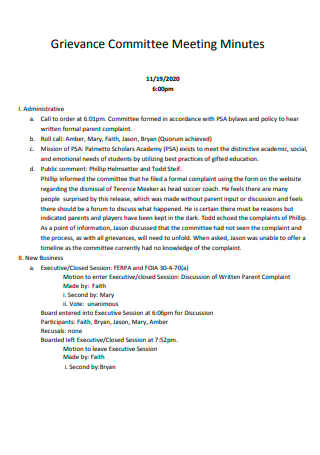
Grievance Committee Meeting Minutes
download now -
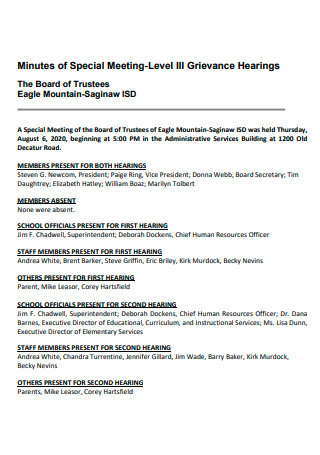
Grievance Hearing Special Meeting Minutes
download now -
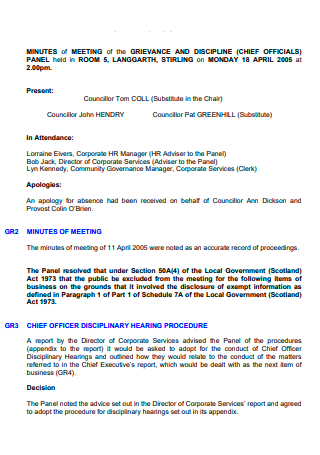
Grievance Meeting Minutes in PDF
download now
FREE Grievance Meeting Minutes s to Download
8+ Sample Grievance Meeting Minutes
What Is Grievance Meeting Minutes?
Benefits of Meeting Minutes
Tips to Start a Meeting
How to Process Employee Grievance
FAQs
What should not be included in meeting minutes?
Should meeting minutes be signed?
Are meeting minutes notes?
What Is Grievance Meeting Minutes?
Grievance meeting minutes are substantially the same as meeting minutes, except that they are written expressly for grievance meetings. They contain and function with the same elements; their contents and usage contexts are the only differences. These official documents record the topics and activities during the conference. It can also serve multiple purposes, such as tracking the group’s overall progress, providing details for future tasks or progress that must be made, and serving as a reliable reference point for future grievance hearings. It includes a list of attendees, the motions raised and the decisions made, and whether or not the employee’s grievances were resolved. It is more of a synopsis of events than a complete transcript. Committees typically appoint the board’s secretary to record meeting minutes. Only eleven percent of company meetings are productive. Although corporations devote approximately 15% of their time to meetings, only a small percentage of meetings are effective. In reality, 71% of the population is considered unproductive.
Benefits of Meeting Minutes
Minute-taking might be a challenging task. It becomes considerably more problematic if you are also expected to participate actively in the meeting. Not only must you pay attention to what everyone is saying, but you must also accurately record the conversations and choices. For some meetings, it may be advisable to have either an internal individual who is not participating in the discussion or an external professional minute taker record the talks, agreements, actions, and conclusions of the meeting. Here are a few of its benefits if you’re still interested.
Tips to Start a Meeting
When done right, meetings can help team members get to know each other better, share information and get feedback, come up with solutions and solve problems, and get people involved in new projects or ideas. For a meeting to be as productive as possible, it’s essential to have a clear goal at the beginning and keep talking about it and working toward that goal throughout the whole thing. Starting a meeting vs. starting it well can make a big difference in how things turn out. Here are some items you can do to make meetings go well:
1. Start on time
Start meetings on time to demonstrate your appreciation for your employees’ time and efforts. To keep the meeting operating smoothly, schedule precise times for breaks, questions, and suggestions. In addition, limit responses to a predetermined number of minutes to eliminate distractions and permit everyone to participate as needed.
2. Have a clear purpose
Meetings should have a well-defined objective. Before beginning a session, explaining why everyone is attending is helpful and how the information delivered will affect them is helpful. It is essential to explain to attendees how the meeting will specifically benefit them. It is necessary that your participants feel they have the authority to participate and that you are willing to listen if you want to receive their ideas effectively. Be explicit about the degree of participation you expect from them, and make them know you’re eager to learn from them. Be forthright about the contribution of their views and ideas to the final product.
3. Make your opening strong
Your introduction establishes the tone for the entire meeting. It is essential to make a strong opening statement if you want everyone to agree with you and the meeting’s purpose immediately. To accomplish this, you must prepare. Before introducing the issues to be addressed, devote some time to generating ideas for capturing the audience’s interest. Consistently paced, high-energy meetings keep participants interested.
4. Set expectations
It is essential to clearly state the meeting’s rules at the outset, such as limiting interruptions when others are speaking. At this time, you can also let people know how much input you need from them and what that might look like during the brainstorming, decision-making, and implementation plans. The objective is not to discourage participation but to make it relevant and valuable. So that you can obtain a variety of ideas and solutions, request that everyone share diverse feedback regarding a topic or problem.
5. Make it personal
People enjoy being acknowledged, especially when they receive accolades. Everyone desires to be appreciated and to know that their efforts are recognized. Introduce a meeting by highlighting the recent achievements of your employees. You can congratulate someone on their accomplishments on various projects or highlight their attitude throughout the workday. Regardless of how you offer praise, doing so boosts employee morale, promotes a more positive workplace, and draws immediate attention. In addition, you generate loyalty because people will be more inclined to attend and participate in future meetings if they know they will receive a personal boost.
How to Process Employee Grievance
Grievance procedures vary from company to company, mainly due to varying collective bargaining agreements and written workplace policies. Nonetheless, grievance resolution procedures in the workplace are frequently standardized. Here is a sample grievance procedure you can use as a template:
1. Informal meeting with supervisor
Encourage employees to consult their manager before filing a formal complaint. Frequently, an informal conversation with a supervisor is sufficient to resolve a complaint or workplace issue. For instance, if an employee feels they deserve a staff promotion but have not received one in several years, a manager may explain why they haven’t been promoted and what they can do to earn one in the future. Managers need to acknowledge employee complaints and actively listen to their concerns.
2. Formal grievance in writing
Consider developing a form for employees to submit grievances. You may also have employees write an email with grievance details. Encourage workers to give as many specifics as possible, such as names and dates. Depending on your grievance procedure policies, you can also have employees make verbal complaints and have their statements documented by a supervisor. Regardless of the method, ensure that the employee’s grievance is documented in writing.
3. Evaluate the grievance
You may elect to involve your human resources department at this stage. In unionized workplaces, this is typically the point at which union representatives intervene on the employee’s behalf. Evaluate the grievance’s specifics to determine the next steps. There may be a simple solution that can be implemented immediately. For example, if an employee receives an incorrect paycheck slip, the grievance could be resolved within minutes. A formal investigation is typically the next step if the grievance is more complex and involves other staff members.
4. Conduct a formal investigation
To do a formal investigation, you may need to talk to the employee who filed the grievance and anyone else involved. Gather as much evidence as possible to help you find a solution. You could also hire a private investigator to do the investigation to make sure the process is fair and unbiased.
5. Resolution
Based on their findings, the investigator, HR, supervisor, and anyone else who is participating in the investigation draft a written conclusion. Inform the employee of your decision and the resulting action. If the worker is not satisfied with the resolution, a mediator may be enlisted to help resolve the matter. Include this in your grievance procedure policy if you allow employees the opportunity to appeal the final verdict.
FAQs
What should not be included in meeting minutes?
Personal reflections and value judgments should not be included in meeting minutes. Each statement must be as objective as possible. Avoid recording everything that was said. The meeting minutes should be concise and summarize the meeting’s key events.
Should meeting minutes be signed?
The corporate secretary should sign the meeting minutes and distribute them to the board of directors for approval. The authenticity of meeting minutes as a legal record depends heavily on signatures and endorsements.
Are meeting minutes notes?
The actual distinction between meeting minutes and meeting notes lies in their usage. Typically, meeting minutes refer to a more formal report of the meeting, whereas meeting notes refer to less proper documentation. Your team’s preference will determine the format you utilize.
The majority, if not all, managers require meeting minutes every time a meeting concludes. It is a handy tool for recording and disseminating information and archival purposes—especially when dealing with issues affecting employees’ personal lives.
